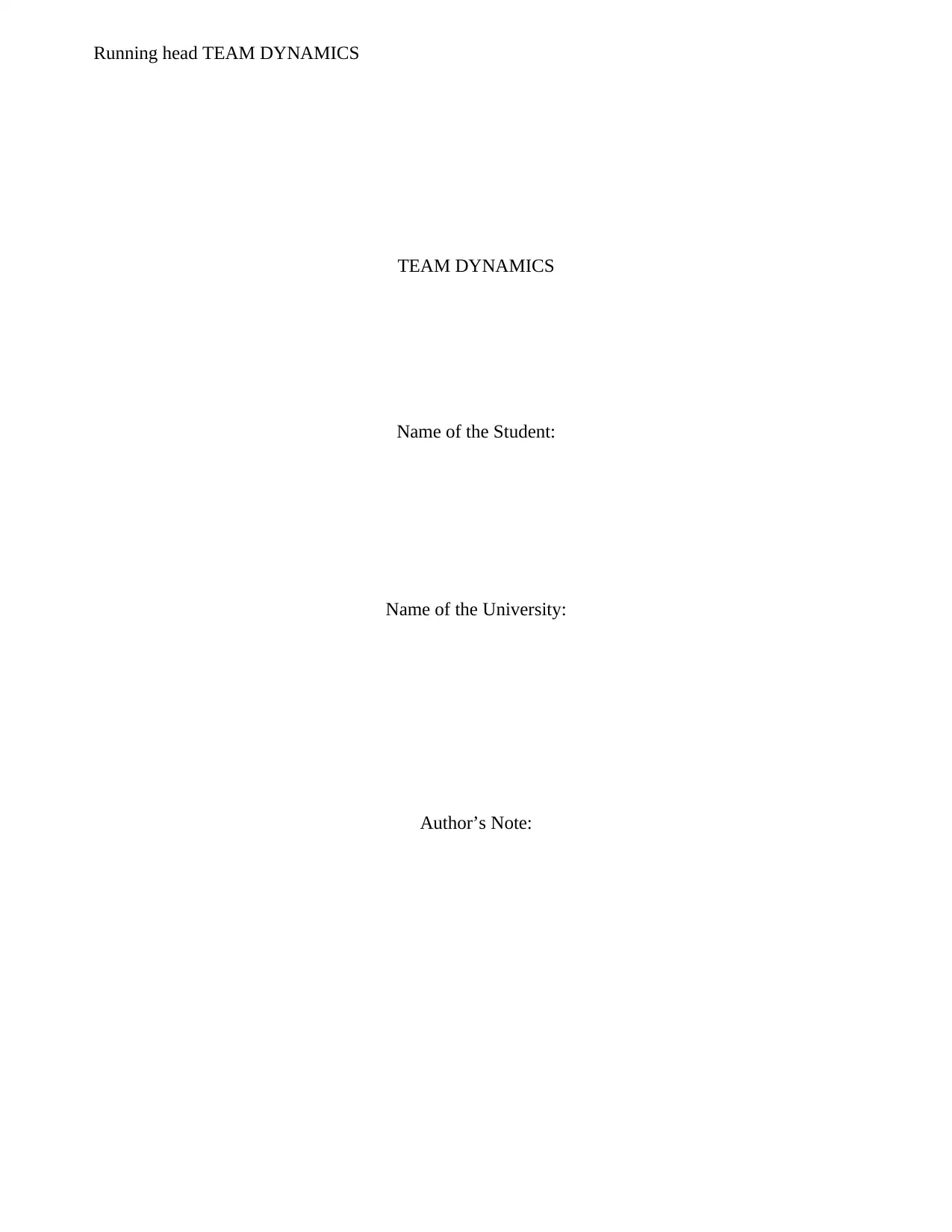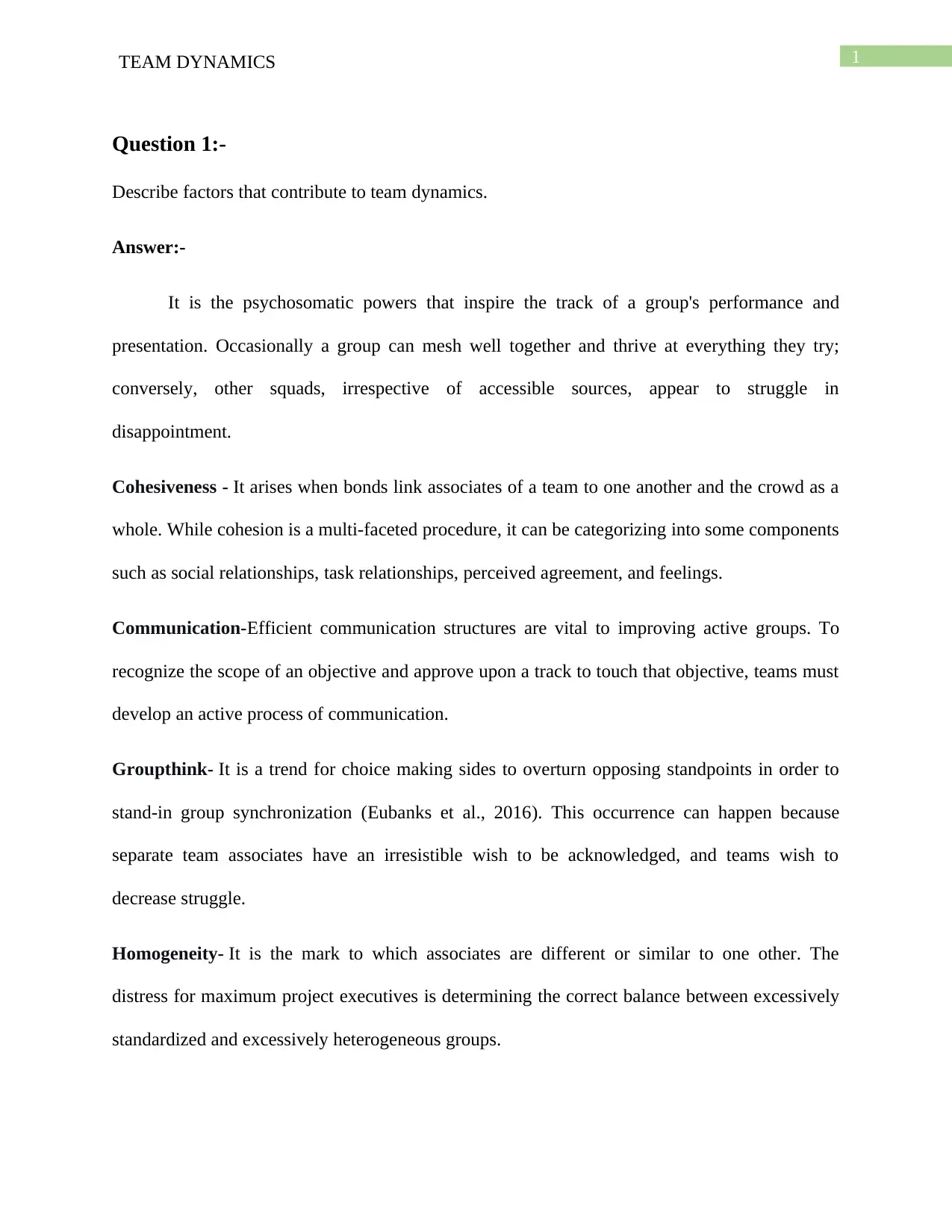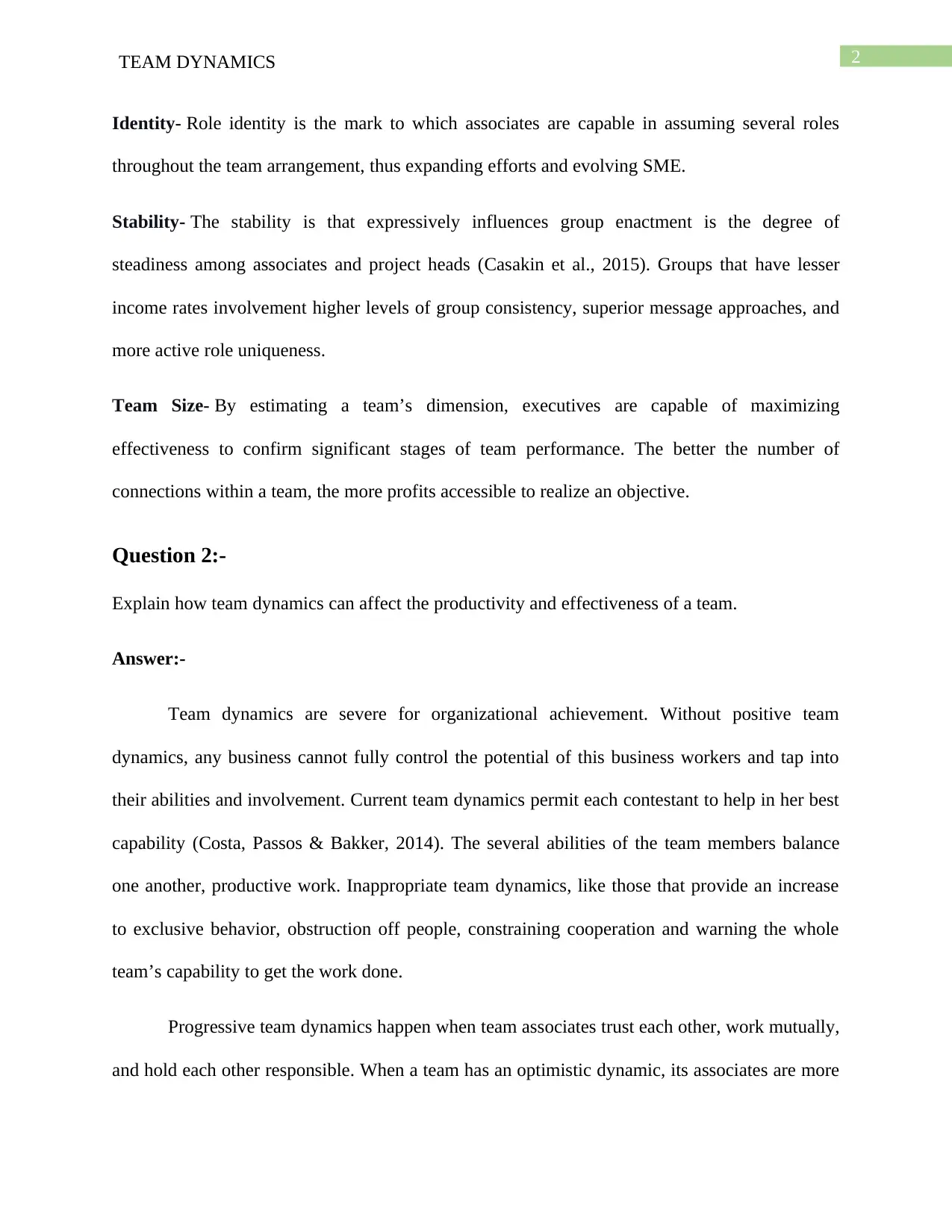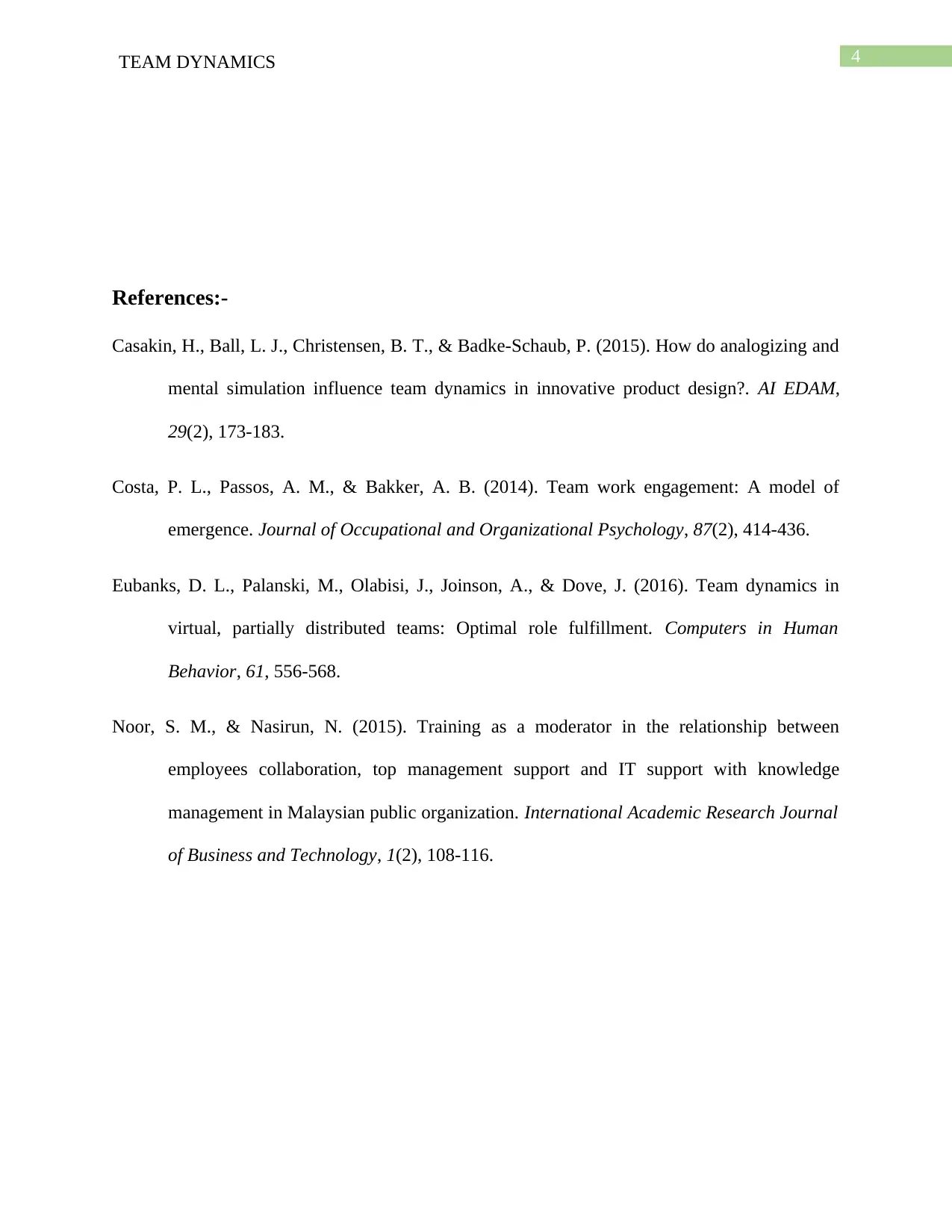Team Dynamics Assignment: Factors, Productivity, and Application
VerifiedAdded on 2022/08/27
|5
|1023
|15
Homework Assignment
AI Summary
This assignment delves into the multifaceted realm of team dynamics, exploring the factors that shape team performance and presentation. It identifies key elements such as cohesiveness, communication, groupthink, homogeneity, identity, stability, and team size, detailing their impact on team function. The assignment then analyzes how these dynamics affect a team's productivity and effectiveness, emphasizing the importance of positive team dynamics for maximizing worker potential and fostering collaboration. Furthermore, it provides insights into applying these concepts in both personal and professional settings, offering practical strategies for enhancing team interactions, improving decision-making, and building strong relationships within teams, ultimately leading to increased productivity and organizational success. The assignment also provides references to support the arguments and findings.

Running head TEAM DYNAMICS
TEAM DYNAMICS
Name of the Student:
Name of the University:
Author’s Note:
TEAM DYNAMICS
Name of the Student:
Name of the University:
Author’s Note:
Paraphrase This Document
Need a fresh take? Get an instant paraphrase of this document with our AI Paraphraser

1TEAM DYNAMICS
Question 1:-
Describe factors that contribute to team dynamics.
Answer:-
It is the psychosomatic powers that inspire the track of a group's performance and
presentation. Occasionally a group can mesh well together and thrive at everything they try;
conversely, other squads, irrespective of accessible sources, appear to struggle in
disappointment.
Cohesiveness - It arises when bonds link associates of a team to one another and the crowd as a
whole. While cohesion is a multi-faceted procedure, it can be categorizing into some components
such as social relationships, task relationships, perceived agreement, and feelings.
Communication-Efficient communication structures are vital to improving active groups. To
recognize the scope of an objective and approve upon a track to touch that objective, teams must
develop an active process of communication.
Groupthink- It is a trend for choice making sides to overturn opposing standpoints in order to
stand-in group synchronization (Eubanks et al., 2016). This occurrence can happen because
separate team associates have an irresistible wish to be acknowledged, and teams wish to
decrease struggle.
Homogeneity- It is the mark to which associates are different or similar to one other. The
distress for maximum project executives is determining the correct balance between excessively
standardized and excessively heterogeneous groups.
Question 1:-
Describe factors that contribute to team dynamics.
Answer:-
It is the psychosomatic powers that inspire the track of a group's performance and
presentation. Occasionally a group can mesh well together and thrive at everything they try;
conversely, other squads, irrespective of accessible sources, appear to struggle in
disappointment.
Cohesiveness - It arises when bonds link associates of a team to one another and the crowd as a
whole. While cohesion is a multi-faceted procedure, it can be categorizing into some components
such as social relationships, task relationships, perceived agreement, and feelings.
Communication-Efficient communication structures are vital to improving active groups. To
recognize the scope of an objective and approve upon a track to touch that objective, teams must
develop an active process of communication.
Groupthink- It is a trend for choice making sides to overturn opposing standpoints in order to
stand-in group synchronization (Eubanks et al., 2016). This occurrence can happen because
separate team associates have an irresistible wish to be acknowledged, and teams wish to
decrease struggle.
Homogeneity- It is the mark to which associates are different or similar to one other. The
distress for maximum project executives is determining the correct balance between excessively
standardized and excessively heterogeneous groups.

2TEAM DYNAMICS
Identity- Role identity is the mark to which associates are capable in assuming several roles
throughout the team arrangement, thus expanding efforts and evolving SME.
Stability- The stability is that expressively influences group enactment is the degree of
steadiness among associates and project heads (Casakin et al., 2015). Groups that have lesser
income rates involvement higher levels of group consistency, superior message approaches, and
more active role uniqueness.
Team Size- By estimating a team’s dimension, executives are capable of maximizing
effectiveness to confirm significant stages of team performance. The better the number of
connections within a team, the more profits accessible to realize an objective.
Question 2:-
Explain how team dynamics can affect the productivity and effectiveness of a team.
Answer:-
Team dynamics are severe for organizational achievement. Without positive team
dynamics, any business cannot fully control the potential of this business workers and tap into
their abilities and involvement. Current team dynamics permit each contestant to help in her best
capability (Costa, Passos & Bakker, 2014). The several abilities of the team members balance
one another, productive work. Inappropriate team dynamics, like those that provide an increase
to exclusive behavior, obstruction off people, constraining cooperation and warning the whole
team’s capability to get the work done.
Progressive team dynamics happen when team associates trust each other, work mutually,
and hold each other responsible. When a team has an optimistic dynamic, its associates are more
Identity- Role identity is the mark to which associates are capable in assuming several roles
throughout the team arrangement, thus expanding efforts and evolving SME.
Stability- The stability is that expressively influences group enactment is the degree of
steadiness among associates and project heads (Casakin et al., 2015). Groups that have lesser
income rates involvement higher levels of group consistency, superior message approaches, and
more active role uniqueness.
Team Size- By estimating a team’s dimension, executives are capable of maximizing
effectiveness to confirm significant stages of team performance. The better the number of
connections within a team, the more profits accessible to realize an objective.
Question 2:-
Explain how team dynamics can affect the productivity and effectiveness of a team.
Answer:-
Team dynamics are severe for organizational achievement. Without positive team
dynamics, any business cannot fully control the potential of this business workers and tap into
their abilities and involvement. Current team dynamics permit each contestant to help in her best
capability (Costa, Passos & Bakker, 2014). The several abilities of the team members balance
one another, productive work. Inappropriate team dynamics, like those that provide an increase
to exclusive behavior, obstruction off people, constraining cooperation and warning the whole
team’s capability to get the work done.
Progressive team dynamics happen when team associates trust each other, work mutually,
and hold each other responsible. When a team has an optimistic dynamic, its associates are more
⊘ This is a preview!⊘
Do you want full access?
Subscribe today to unlock all pages.

Trusted by 1+ million students worldwide

3TEAM DYNAMICS
productive, and there is a fewer possibility of conflict. An effective team dynamics can help to
create a good relationship between staff. For this reason, the team can generate extreme mental
stability, which can be useful for organizational benefit and productivity.
Question 3:-
Describe how you can apply this information in your own personal or professional life.
Answer:-
Team dynamics can be used for professional human life by getting to recognize their
team. Initially, the human being can converse with their teammates on the specific goals they
want to meet. If any people can make a proper roadmap in an initial phase, then they can easily
be motivated for their work. Apart from this, one of the most significant team-building
guidelines is to match their team members’ abilities to their job accountabilities. Then he will
discover the fulfillment of the team will be higher and that output will soar (Noor & Nasirun,
2015). A strong team dynamic cannot survive without stable persons. If the team members can
follow the team leads guidelines, then the team must be successful. It was evident that the team
lead should create a good bonding between their workers.
In personal life, the human can also maintain the team dynamics. If the person has a
family, then they should create a good relationship between them and also makes a perfect
bonding. In the time of decision making, the person can take every member's opinion. It is the
critical aspect of a team's dynamics of personal human life.
productive, and there is a fewer possibility of conflict. An effective team dynamics can help to
create a good relationship between staff. For this reason, the team can generate extreme mental
stability, which can be useful for organizational benefit and productivity.
Question 3:-
Describe how you can apply this information in your own personal or professional life.
Answer:-
Team dynamics can be used for professional human life by getting to recognize their
team. Initially, the human being can converse with their teammates on the specific goals they
want to meet. If any people can make a proper roadmap in an initial phase, then they can easily
be motivated for their work. Apart from this, one of the most significant team-building
guidelines is to match their team members’ abilities to their job accountabilities. Then he will
discover the fulfillment of the team will be higher and that output will soar (Noor & Nasirun,
2015). A strong team dynamic cannot survive without stable persons. If the team members can
follow the team leads guidelines, then the team must be successful. It was evident that the team
lead should create a good bonding between their workers.
In personal life, the human can also maintain the team dynamics. If the person has a
family, then they should create a good relationship between them and also makes a perfect
bonding. In the time of decision making, the person can take every member's opinion. It is the
critical aspect of a team's dynamics of personal human life.
Paraphrase This Document
Need a fresh take? Get an instant paraphrase of this document with our AI Paraphraser

4TEAM DYNAMICS
References:-
Casakin, H., Ball, L. J., Christensen, B. T., & Badke-Schaub, P. (2015). How do analogizing and
mental simulation influence team dynamics in innovative product design?. AI EDAM,
29(2), 173-183.
Costa, P. L., Passos, A. M., & Bakker, A. B. (2014). Team work engagement: A model of
emergence. Journal of Occupational and Organizational Psychology, 87(2), 414-436.
Eubanks, D. L., Palanski, M., Olabisi, J., Joinson, A., & Dove, J. (2016). Team dynamics in
virtual, partially distributed teams: Optimal role fulfillment. Computers in Human
Behavior, 61, 556-568.
Noor, S. M., & Nasirun, N. (2015). Training as a moderator in the relationship between
employees collaboration, top management support and IT support with knowledge
management in Malaysian public organization. International Academic Research Journal
of Business and Technology, 1(2), 108-116.
References:-
Casakin, H., Ball, L. J., Christensen, B. T., & Badke-Schaub, P. (2015). How do analogizing and
mental simulation influence team dynamics in innovative product design?. AI EDAM,
29(2), 173-183.
Costa, P. L., Passos, A. M., & Bakker, A. B. (2014). Team work engagement: A model of
emergence. Journal of Occupational and Organizational Psychology, 87(2), 414-436.
Eubanks, D. L., Palanski, M., Olabisi, J., Joinson, A., & Dove, J. (2016). Team dynamics in
virtual, partially distributed teams: Optimal role fulfillment. Computers in Human
Behavior, 61, 556-568.
Noor, S. M., & Nasirun, N. (2015). Training as a moderator in the relationship between
employees collaboration, top management support and IT support with knowledge
management in Malaysian public organization. International Academic Research Journal
of Business and Technology, 1(2), 108-116.
1 out of 5
Related Documents
Your All-in-One AI-Powered Toolkit for Academic Success.
+13062052269
info@desklib.com
Available 24*7 on WhatsApp / Email
![[object Object]](/_next/static/media/star-bottom.7253800d.svg)
Unlock your academic potential
Copyright © 2020–2025 A2Z Services. All Rights Reserved. Developed and managed by ZUCOL.





